Supply Chain Management and Information System: Welch Foods Case
VerifiedAdded on 2023/01/18
|21
|5168
|33
Report
AI Summary
This report examines the implementation of Enterprise Resource Planning (ERP) and Supply Chain Management (SCM) systems within Welch Foods Inc., focusing on the Oracle E-Business Suite. The report begins with an introduction to the importance of SCM and ERP systems, followed by a literature review that explores the role of information systems in SCM, including discussions on operational efficiency, strategic planning, and the reduction of the bullwhip effect. A case study is then presented, providing an overview of Welch Foods Inc., its supply chain network, and the Oracle SCM system implemented. The report details integration methods, the impact of the ERP system on Welch's business operations, and concludes with a summary of the findings, emphasizing the benefits of effective information system utilization in enhancing operational flexibility, reducing costs, and improving customer service. The report also considers the challenges and opportunities of SCM and ERP adoption.
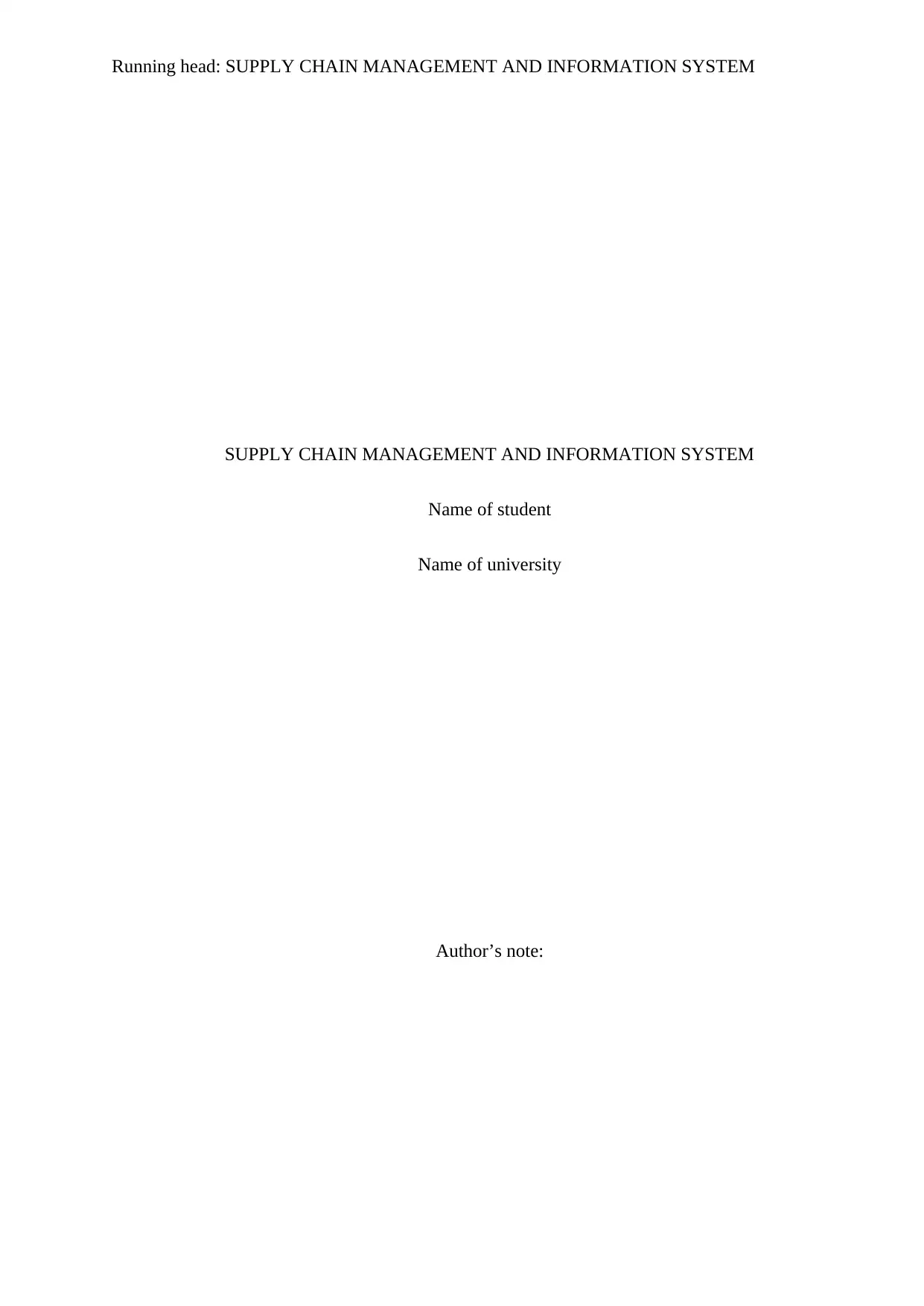
Running head: SUPPLY CHAIN MANAGEMENT AND INFORMATION SYSTEM
SUPPLY CHAIN MANAGEMENT AND INFORMATION SYSTEM
Name of student
Name of university
Author’s note:
SUPPLY CHAIN MANAGEMENT AND INFORMATION SYSTEM
Name of student
Name of university
Author’s note:
Paraphrase This Document
Need a fresh take? Get an instant paraphrase of this document with our AI Paraphraser
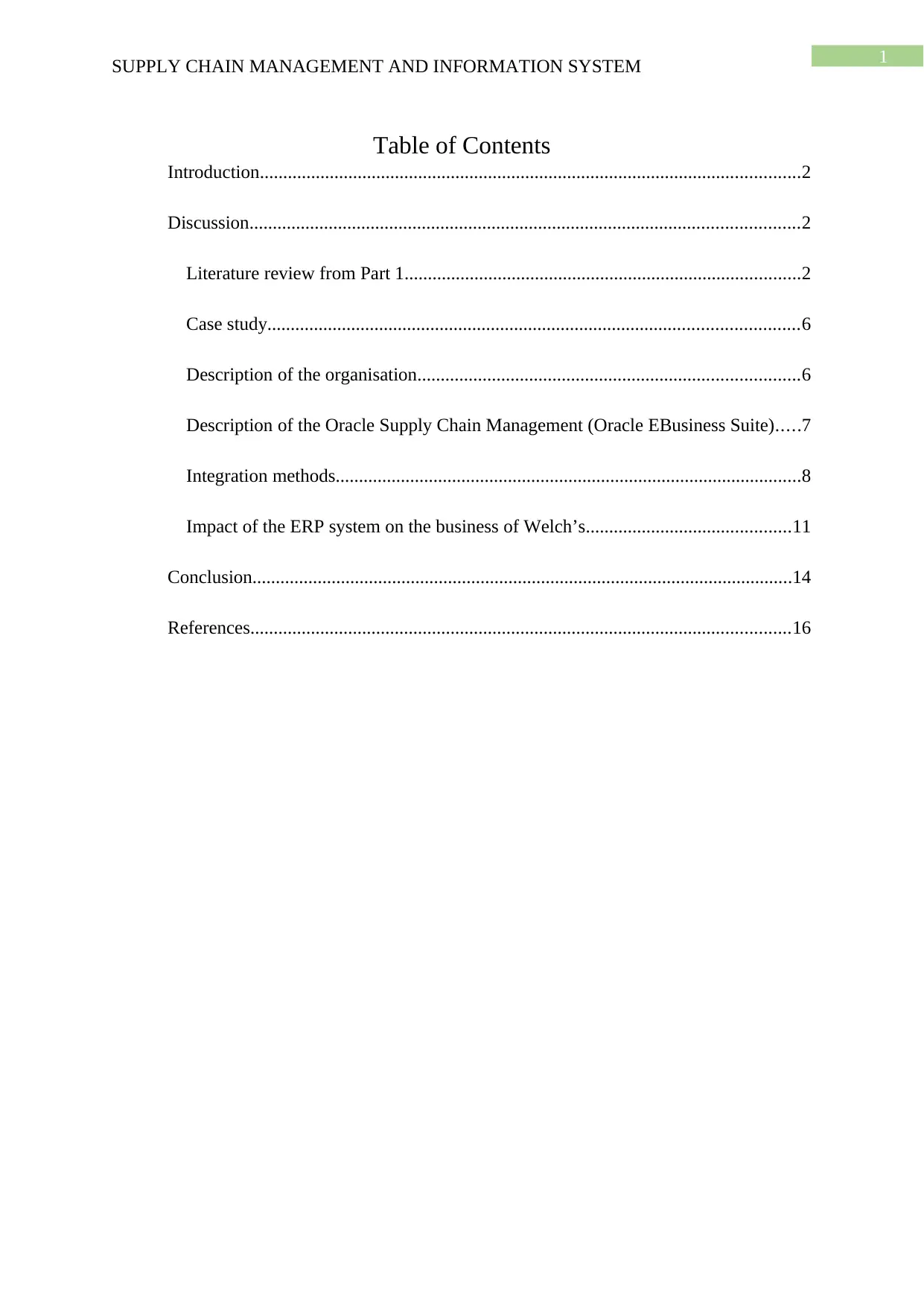
1
SUPPLY CHAIN MANAGEMENT AND INFORMATION SYSTEM
Table of Contents
Introduction....................................................................................................................2
Discussion......................................................................................................................2
Literature review from Part 1.....................................................................................2
Case study..................................................................................................................6
Description of the organisation..................................................................................6
Description of the Oracle Supply Chain Management (Oracle EBusiness Suite).....7
Integration methods....................................................................................................8
Impact of the ERP system on the business of Welch’s............................................11
Conclusion....................................................................................................................14
References....................................................................................................................16
SUPPLY CHAIN MANAGEMENT AND INFORMATION SYSTEM
Table of Contents
Introduction....................................................................................................................2
Discussion......................................................................................................................2
Literature review from Part 1.....................................................................................2
Case study..................................................................................................................6
Description of the organisation..................................................................................6
Description of the Oracle Supply Chain Management (Oracle EBusiness Suite).....7
Integration methods....................................................................................................8
Impact of the ERP system on the business of Welch’s............................................11
Conclusion....................................................................................................................14
References....................................................................................................................16
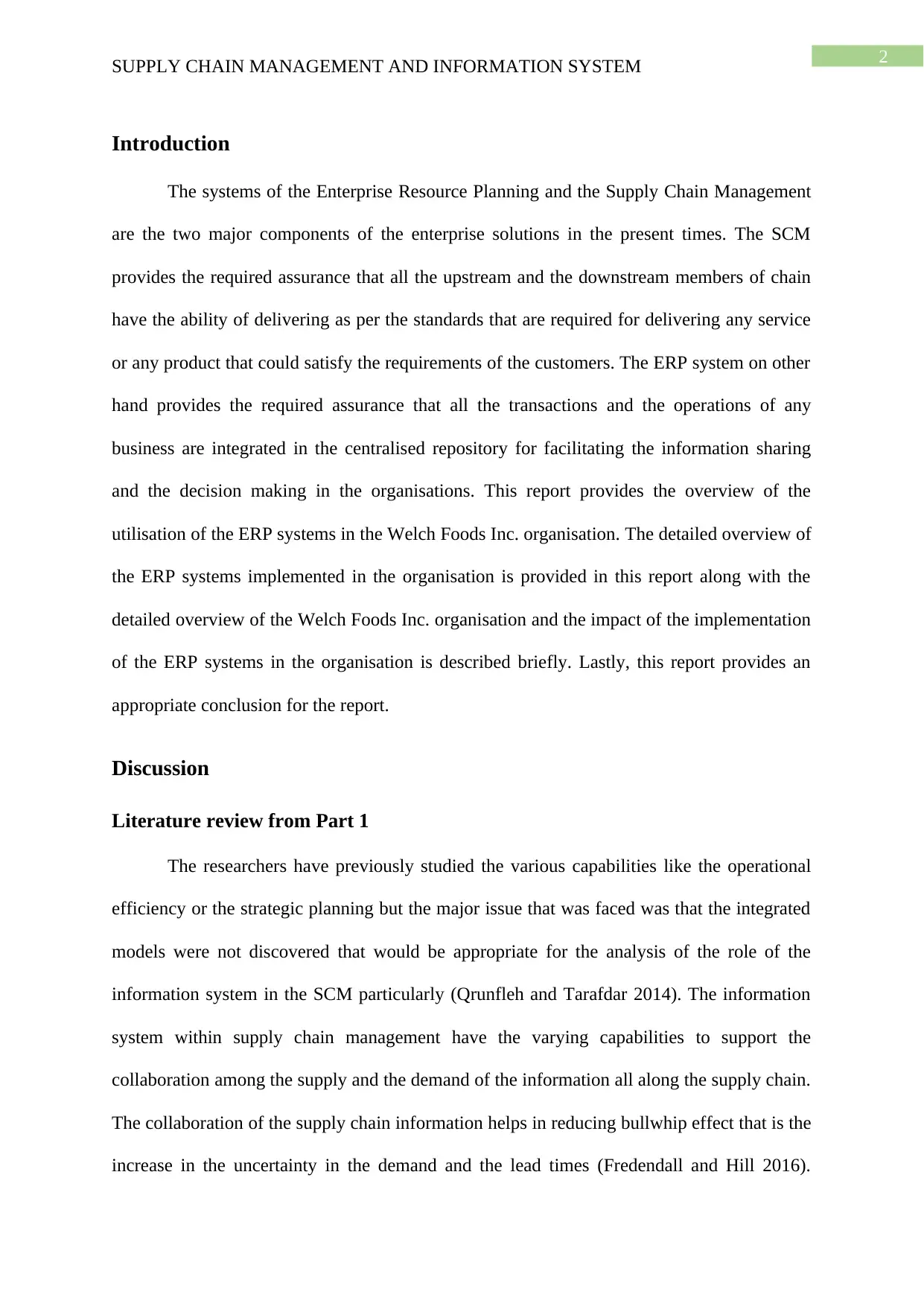
2
SUPPLY CHAIN MANAGEMENT AND INFORMATION SYSTEM
Introduction
The systems of the Enterprise Resource Planning and the Supply Chain Management
are the two major components of the enterprise solutions in the present times. The SCM
provides the required assurance that all the upstream and the downstream members of chain
have the ability of delivering as per the standards that are required for delivering any service
or any product that could satisfy the requirements of the customers. The ERP system on other
hand provides the required assurance that all the transactions and the operations of any
business are integrated in the centralised repository for facilitating the information sharing
and the decision making in the organisations. This report provides the overview of the
utilisation of the ERP systems in the Welch Foods Inc. organisation. The detailed overview of
the ERP systems implemented in the organisation is provided in this report along with the
detailed overview of the Welch Foods Inc. organisation and the impact of the implementation
of the ERP systems in the organisation is described briefly. Lastly, this report provides an
appropriate conclusion for the report.
Discussion
Literature review from Part 1
The researchers have previously studied the various capabilities like the operational
efficiency or the strategic planning but the major issue that was faced was that the integrated
models were not discovered that would be appropriate for the analysis of the role of the
information system in the SCM particularly (Qrunfleh and Tarafdar 2014). The information
system within supply chain management have the varying capabilities to support the
collaboration among the supply and the demand of the information all along the supply chain.
The collaboration of the supply chain information helps in reducing bullwhip effect that is the
increase in the uncertainty in the demand and the lead times (Fredendall and Hill 2016).
SUPPLY CHAIN MANAGEMENT AND INFORMATION SYSTEM
Introduction
The systems of the Enterprise Resource Planning and the Supply Chain Management
are the two major components of the enterprise solutions in the present times. The SCM
provides the required assurance that all the upstream and the downstream members of chain
have the ability of delivering as per the standards that are required for delivering any service
or any product that could satisfy the requirements of the customers. The ERP system on other
hand provides the required assurance that all the transactions and the operations of any
business are integrated in the centralised repository for facilitating the information sharing
and the decision making in the organisations. This report provides the overview of the
utilisation of the ERP systems in the Welch Foods Inc. organisation. The detailed overview of
the ERP systems implemented in the organisation is provided in this report along with the
detailed overview of the Welch Foods Inc. organisation and the impact of the implementation
of the ERP systems in the organisation is described briefly. Lastly, this report provides an
appropriate conclusion for the report.
Discussion
Literature review from Part 1
The researchers have previously studied the various capabilities like the operational
efficiency or the strategic planning but the major issue that was faced was that the integrated
models were not discovered that would be appropriate for the analysis of the role of the
information system in the SCM particularly (Qrunfleh and Tarafdar 2014). The information
system within supply chain management have the varying capabilities to support the
collaboration among the supply and the demand of the information all along the supply chain.
The collaboration of the supply chain information helps in reducing bullwhip effect that is the
increase in the uncertainty in the demand and the lead times (Fredendall and Hill 2016).
⊘ This is a preview!⊘
Do you want full access?
Subscribe today to unlock all pages.

Trusted by 1+ million students worldwide
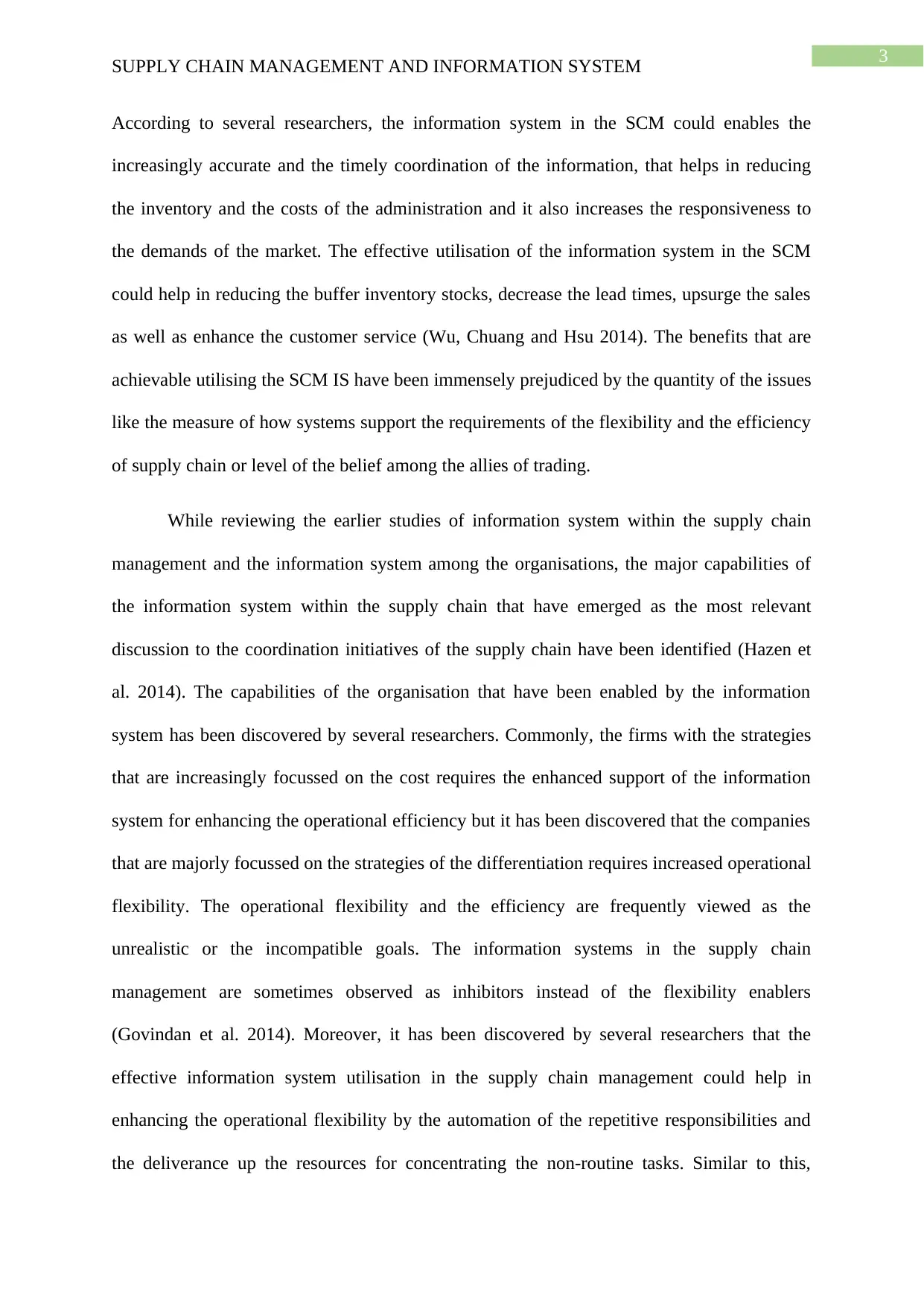
3
SUPPLY CHAIN MANAGEMENT AND INFORMATION SYSTEM
According to several researchers, the information system in the SCM could enables the
increasingly accurate and the timely coordination of the information, that helps in reducing
the inventory and the costs of the administration and it also increases the responsiveness to
the demands of the market. The effective utilisation of the information system in the SCM
could help in reducing the buffer inventory stocks, decrease the lead times, upsurge the sales
as well as enhance the customer service (Wu, Chuang and Hsu 2014). The benefits that are
achievable utilising the SCM IS have been immensely prejudiced by the quantity of the issues
like the measure of how systems support the requirements of the flexibility and the efficiency
of supply chain or level of the belief among the allies of trading.
While reviewing the earlier studies of information system within the supply chain
management and the information system among the organisations, the major capabilities of
the information system within the supply chain that have emerged as the most relevant
discussion to the coordination initiatives of the supply chain have been identified (Hazen et
al. 2014). The capabilities of the organisation that have been enabled by the information
system has been discovered by several researchers. Commonly, the firms with the strategies
that are increasingly focussed on the cost requires the enhanced support of the information
system for enhancing the operational efficiency but it has been discovered that the companies
that are majorly focussed on the strategies of the differentiation requires increased operational
flexibility. The operational flexibility and the efficiency are frequently viewed as the
unrealistic or the incompatible goals. The information systems in the supply chain
management are sometimes observed as inhibitors instead of the flexibility enablers
(Govindan et al. 2014). Moreover, it has been discovered by several researchers that the
effective information system utilisation in the supply chain management could help in
enhancing the operational flexibility by the automation of the repetitive responsibilities and
the deliverance up the resources for concentrating the non-routine tasks. Similar to this,
SUPPLY CHAIN MANAGEMENT AND INFORMATION SYSTEM
According to several researchers, the information system in the SCM could enables the
increasingly accurate and the timely coordination of the information, that helps in reducing
the inventory and the costs of the administration and it also increases the responsiveness to
the demands of the market. The effective utilisation of the information system in the SCM
could help in reducing the buffer inventory stocks, decrease the lead times, upsurge the sales
as well as enhance the customer service (Wu, Chuang and Hsu 2014). The benefits that are
achievable utilising the SCM IS have been immensely prejudiced by the quantity of the issues
like the measure of how systems support the requirements of the flexibility and the efficiency
of supply chain or level of the belief among the allies of trading.
While reviewing the earlier studies of information system within the supply chain
management and the information system among the organisations, the major capabilities of
the information system within the supply chain that have emerged as the most relevant
discussion to the coordination initiatives of the supply chain have been identified (Hazen et
al. 2014). The capabilities of the organisation that have been enabled by the information
system has been discovered by several researchers. Commonly, the firms with the strategies
that are increasingly focussed on the cost requires the enhanced support of the information
system for enhancing the operational efficiency but it has been discovered that the companies
that are majorly focussed on the strategies of the differentiation requires increased operational
flexibility. The operational flexibility and the efficiency are frequently viewed as the
unrealistic or the incompatible goals. The information systems in the supply chain
management are sometimes observed as inhibitors instead of the flexibility enablers
(Govindan et al. 2014). Moreover, it has been discovered by several researchers that the
effective information system utilisation in the supply chain management could help in
enhancing the operational flexibility by the automation of the repetitive responsibilities and
the deliverance up the resources for concentrating the non-routine tasks. Similar to this,
Paraphrase This Document
Need a fresh take? Get an instant paraphrase of this document with our AI Paraphraser
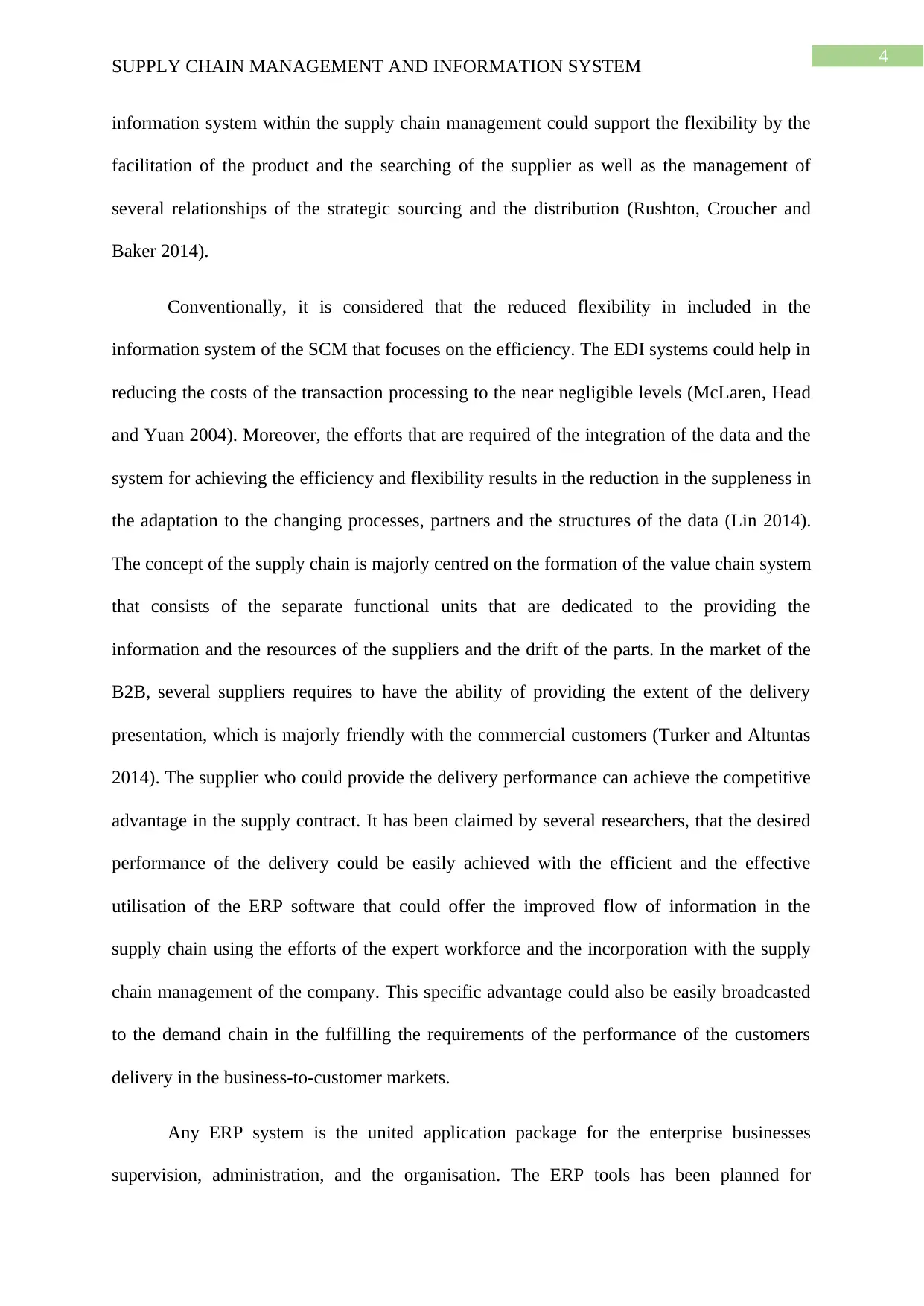
4
SUPPLY CHAIN MANAGEMENT AND INFORMATION SYSTEM
information system within the supply chain management could support the flexibility by the
facilitation of the product and the searching of the supplier as well as the management of
several relationships of the strategic sourcing and the distribution (Rushton, Croucher and
Baker 2014).
Conventionally, it is considered that the reduced flexibility in included in the
information system of the SCM that focuses on the efficiency. The EDI systems could help in
reducing the costs of the transaction processing to the near negligible levels (McLaren, Head
and Yuan 2004). Moreover, the efforts that are required of the integration of the data and the
system for achieving the efficiency and flexibility results in the reduction in the suppleness in
the adaptation to the changing processes, partners and the structures of the data (Lin 2014).
The concept of the supply chain is majorly centred on the formation of the value chain system
that consists of the separate functional units that are dedicated to the providing the
information and the resources of the suppliers and the drift of the parts. In the market of the
B2B, several suppliers requires to have the ability of providing the extent of the delivery
presentation, which is majorly friendly with the commercial customers (Turker and Altuntas
2014). The supplier who could provide the delivery performance can achieve the competitive
advantage in the supply contract. It has been claimed by several researchers, that the desired
performance of the delivery could be easily achieved with the efficient and the effective
utilisation of the ERP software that could offer the improved flow of information in the
supply chain using the efforts of the expert workforce and the incorporation with the supply
chain management of the company. This specific advantage could also be easily broadcasted
to the demand chain in the fulfilling the requirements of the performance of the customers
delivery in the business-to-customer markets.
Any ERP system is the united application package for the enterprise businesses
supervision, administration, and the organisation. The ERP tools has been planned for
SUPPLY CHAIN MANAGEMENT AND INFORMATION SYSTEM
information system within the supply chain management could support the flexibility by the
facilitation of the product and the searching of the supplier as well as the management of
several relationships of the strategic sourcing and the distribution (Rushton, Croucher and
Baker 2014).
Conventionally, it is considered that the reduced flexibility in included in the
information system of the SCM that focuses on the efficiency. The EDI systems could help in
reducing the costs of the transaction processing to the near negligible levels (McLaren, Head
and Yuan 2004). Moreover, the efforts that are required of the integration of the data and the
system for achieving the efficiency and flexibility results in the reduction in the suppleness in
the adaptation to the changing processes, partners and the structures of the data (Lin 2014).
The concept of the supply chain is majorly centred on the formation of the value chain system
that consists of the separate functional units that are dedicated to the providing the
information and the resources of the suppliers and the drift of the parts. In the market of the
B2B, several suppliers requires to have the ability of providing the extent of the delivery
presentation, which is majorly friendly with the commercial customers (Turker and Altuntas
2014). The supplier who could provide the delivery performance can achieve the competitive
advantage in the supply contract. It has been claimed by several researchers, that the desired
performance of the delivery could be easily achieved with the efficient and the effective
utilisation of the ERP software that could offer the improved flow of information in the
supply chain using the efforts of the expert workforce and the incorporation with the supply
chain management of the company. This specific advantage could also be easily broadcasted
to the demand chain in the fulfilling the requirements of the performance of the customers
delivery in the business-to-customer markets.
Any ERP system is the united application package for the enterprise businesses
supervision, administration, and the organisation. The ERP tools has been planned for
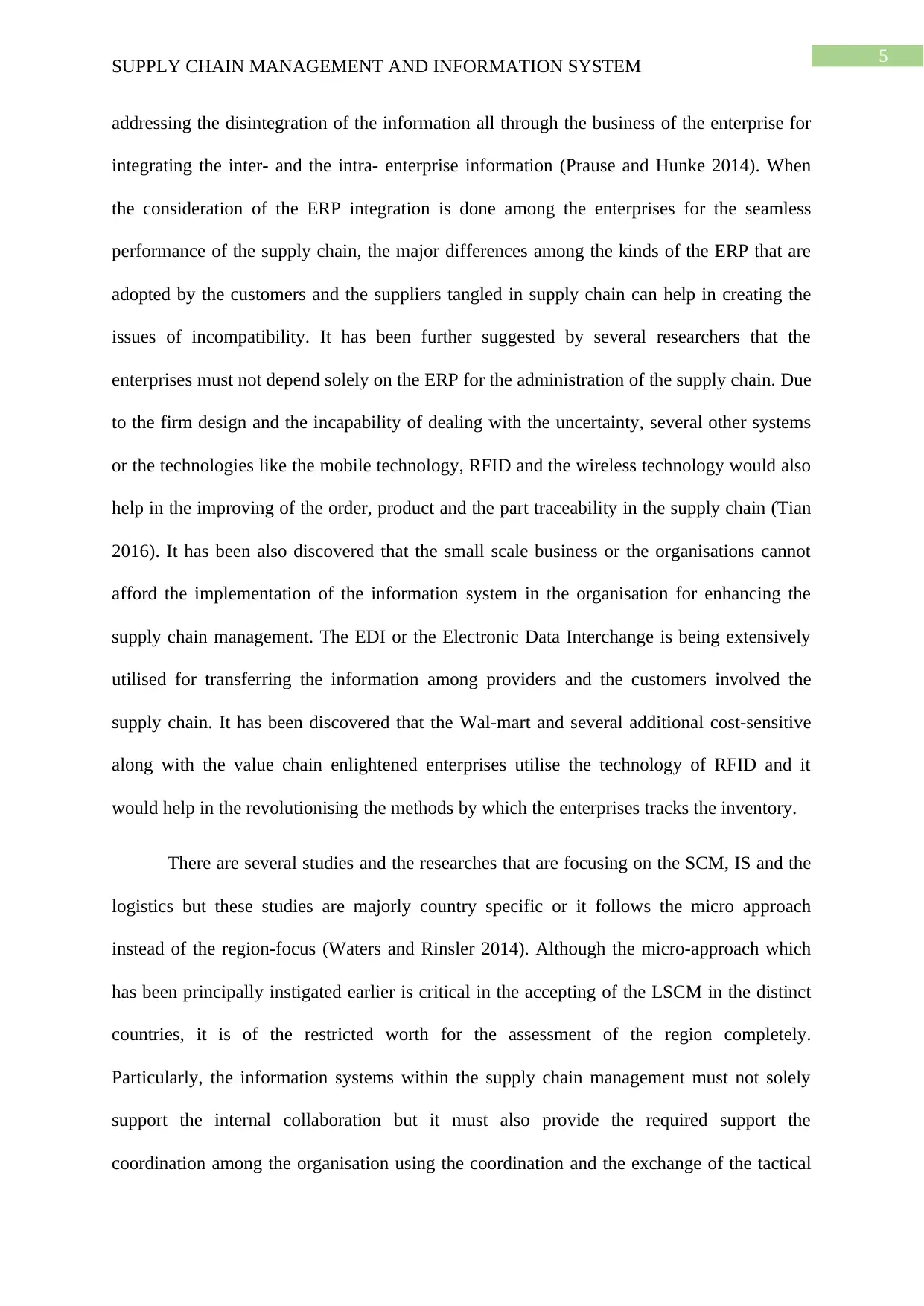
5
SUPPLY CHAIN MANAGEMENT AND INFORMATION SYSTEM
addressing the disintegration of the information all through the business of the enterprise for
integrating the inter- and the intra- enterprise information (Prause and Hunke 2014). When
the consideration of the ERP integration is done among the enterprises for the seamless
performance of the supply chain, the major differences among the kinds of the ERP that are
adopted by the customers and the suppliers tangled in supply chain can help in creating the
issues of incompatibility. It has been further suggested by several researchers that the
enterprises must not depend solely on the ERP for the administration of the supply chain. Due
to the firm design and the incapability of dealing with the uncertainty, several other systems
or the technologies like the mobile technology, RFID and the wireless technology would also
help in the improving of the order, product and the part traceability in the supply chain (Tian
2016). It has been also discovered that the small scale business or the organisations cannot
afford the implementation of the information system in the organisation for enhancing the
supply chain management. The EDI or the Electronic Data Interchange is being extensively
utilised for transferring the information among providers and the customers involved the
supply chain. It has been discovered that the Wal-mart and several additional cost-sensitive
along with the value chain enlightened enterprises utilise the technology of RFID and it
would help in the revolutionising the methods by which the enterprises tracks the inventory.
There are several studies and the researches that are focusing on the SCM, IS and the
logistics but these studies are majorly country specific or it follows the micro approach
instead of the region-focus (Waters and Rinsler 2014). Although the micro-approach which
has been principally instigated earlier is critical in the accepting of the LSCM in the distinct
countries, it is of the restricted worth for the assessment of the region completely.
Particularly, the information systems within the supply chain management must not solely
support the internal collaboration but it must also provide the required support the
coordination among the organisation using the coordination and the exchange of the tactical
SUPPLY CHAIN MANAGEMENT AND INFORMATION SYSTEM
addressing the disintegration of the information all through the business of the enterprise for
integrating the inter- and the intra- enterprise information (Prause and Hunke 2014). When
the consideration of the ERP integration is done among the enterprises for the seamless
performance of the supply chain, the major differences among the kinds of the ERP that are
adopted by the customers and the suppliers tangled in supply chain can help in creating the
issues of incompatibility. It has been further suggested by several researchers that the
enterprises must not depend solely on the ERP for the administration of the supply chain. Due
to the firm design and the incapability of dealing with the uncertainty, several other systems
or the technologies like the mobile technology, RFID and the wireless technology would also
help in the improving of the order, product and the part traceability in the supply chain (Tian
2016). It has been also discovered that the small scale business or the organisations cannot
afford the implementation of the information system in the organisation for enhancing the
supply chain management. The EDI or the Electronic Data Interchange is being extensively
utilised for transferring the information among providers and the customers involved the
supply chain. It has been discovered that the Wal-mart and several additional cost-sensitive
along with the value chain enlightened enterprises utilise the technology of RFID and it
would help in the revolutionising the methods by which the enterprises tracks the inventory.
There are several studies and the researches that are focusing on the SCM, IS and the
logistics but these studies are majorly country specific or it follows the micro approach
instead of the region-focus (Waters and Rinsler 2014). Although the micro-approach which
has been principally instigated earlier is critical in the accepting of the LSCM in the distinct
countries, it is of the restricted worth for the assessment of the region completely.
Particularly, the information systems within the supply chain management must not solely
support the internal collaboration but it must also provide the required support the
coordination among the organisation using the coordination and the exchange of the tactical
⊘ This is a preview!⊘
Do you want full access?
Subscribe today to unlock all pages.

Trusted by 1+ million students worldwide
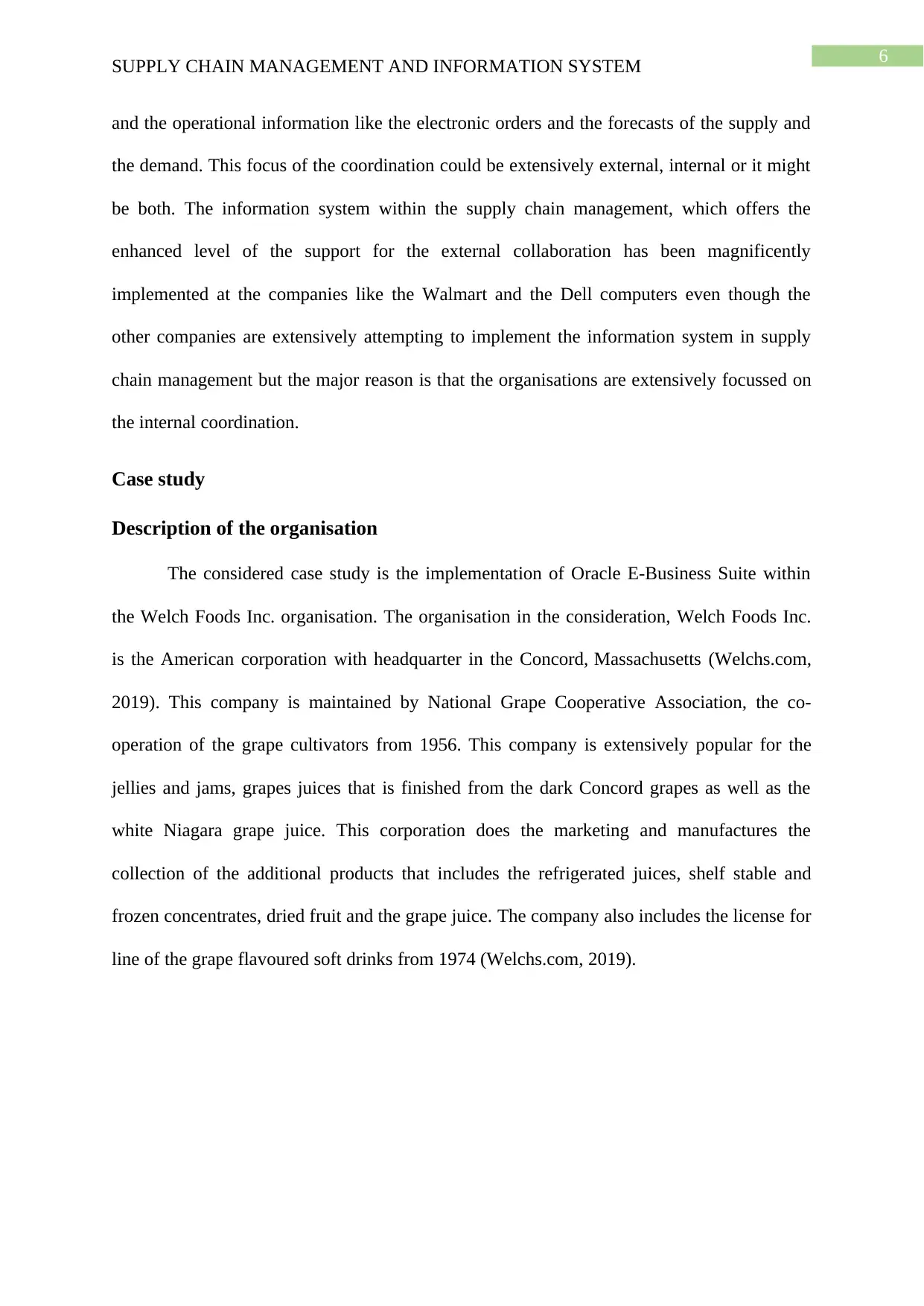
6
SUPPLY CHAIN MANAGEMENT AND INFORMATION SYSTEM
and the operational information like the electronic orders and the forecasts of the supply and
the demand. This focus of the coordination could be extensively external, internal or it might
be both. The information system within the supply chain management, which offers the
enhanced level of the support for the external collaboration has been magnificently
implemented at the companies like the Walmart and the Dell computers even though the
other companies are extensively attempting to implement the information system in supply
chain management but the major reason is that the organisations are extensively focussed on
the internal coordination.
Case study
Description of the organisation
The considered case study is the implementation of Oracle E-Business Suite within
the Welch Foods Inc. organisation. The organisation in the consideration, Welch Foods Inc.
is the American corporation with headquarter in the Concord, Massachusetts (Welchs.com,
2019). This company is maintained by National Grape Cooperative Association, the co-
operation of the grape cultivators from 1956. This company is extensively popular for the
jellies and jams, grapes juices that is finished from the dark Concord grapes as well as the
white Niagara grape juice. This corporation does the marketing and manufactures the
collection of the additional products that includes the refrigerated juices, shelf stable and
frozen concentrates, dried fruit and the grape juice. The company also includes the license for
line of the grape flavoured soft drinks from 1974 (Welchs.com, 2019).
SUPPLY CHAIN MANAGEMENT AND INFORMATION SYSTEM
and the operational information like the electronic orders and the forecasts of the supply and
the demand. This focus of the coordination could be extensively external, internal or it might
be both. The information system within the supply chain management, which offers the
enhanced level of the support for the external collaboration has been magnificently
implemented at the companies like the Walmart and the Dell computers even though the
other companies are extensively attempting to implement the information system in supply
chain management but the major reason is that the organisations are extensively focussed on
the internal coordination.
Case study
Description of the organisation
The considered case study is the implementation of Oracle E-Business Suite within
the Welch Foods Inc. organisation. The organisation in the consideration, Welch Foods Inc.
is the American corporation with headquarter in the Concord, Massachusetts (Welchs.com,
2019). This company is maintained by National Grape Cooperative Association, the co-
operation of the grape cultivators from 1956. This company is extensively popular for the
jellies and jams, grapes juices that is finished from the dark Concord grapes as well as the
white Niagara grape juice. This corporation does the marketing and manufactures the
collection of the additional products that includes the refrigerated juices, shelf stable and
frozen concentrates, dried fruit and the grape juice. The company also includes the license for
line of the grape flavoured soft drinks from 1974 (Welchs.com, 2019).
Paraphrase This Document
Need a fresh take? Get an instant paraphrase of this document with our AI Paraphraser
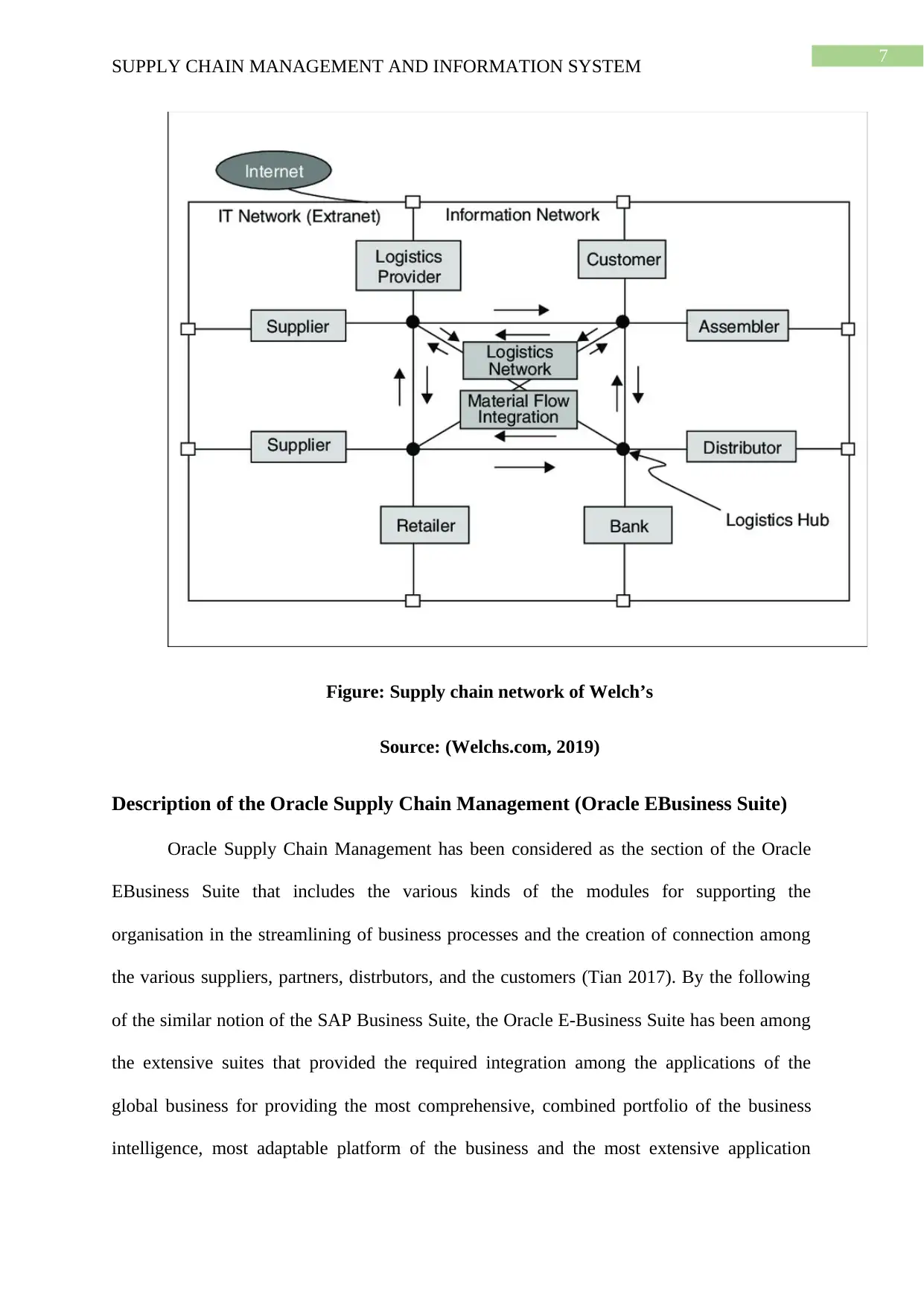
7
SUPPLY CHAIN MANAGEMENT AND INFORMATION SYSTEM
Figure: Supply chain network of Welch’s
Source: (Welchs.com, 2019)
Description of the Oracle Supply Chain Management (Oracle EBusiness Suite)
Oracle Supply Chain Management has been considered as the section of the Oracle
EBusiness Suite that includes the various kinds of the modules for supporting the
organisation in the streamlining of business processes and the creation of connection among
the various suppliers, partners, distrbutors, and the customers (Tian 2017). By the following
of the similar notion of the SAP Business Suite, the Oracle E-Business Suite has been among
the extensive suites that provided the required integration among the applications of the
global business for providing the most comprehensive, combined portfolio of the business
intelligence, most adaptable platform of the business and the most extensive application
SUPPLY CHAIN MANAGEMENT AND INFORMATION SYSTEM
Figure: Supply chain network of Welch’s
Source: (Welchs.com, 2019)
Description of the Oracle Supply Chain Management (Oracle EBusiness Suite)
Oracle Supply Chain Management has been considered as the section of the Oracle
EBusiness Suite that includes the various kinds of the modules for supporting the
organisation in the streamlining of business processes and the creation of connection among
the various suppliers, partners, distrbutors, and the customers (Tian 2017). By the following
of the similar notion of the SAP Business Suite, the Oracle E-Business Suite has been among
the extensive suites that provided the required integration among the applications of the
global business for providing the most comprehensive, combined portfolio of the business
intelligence, most adaptable platform of the business and the most extensive application
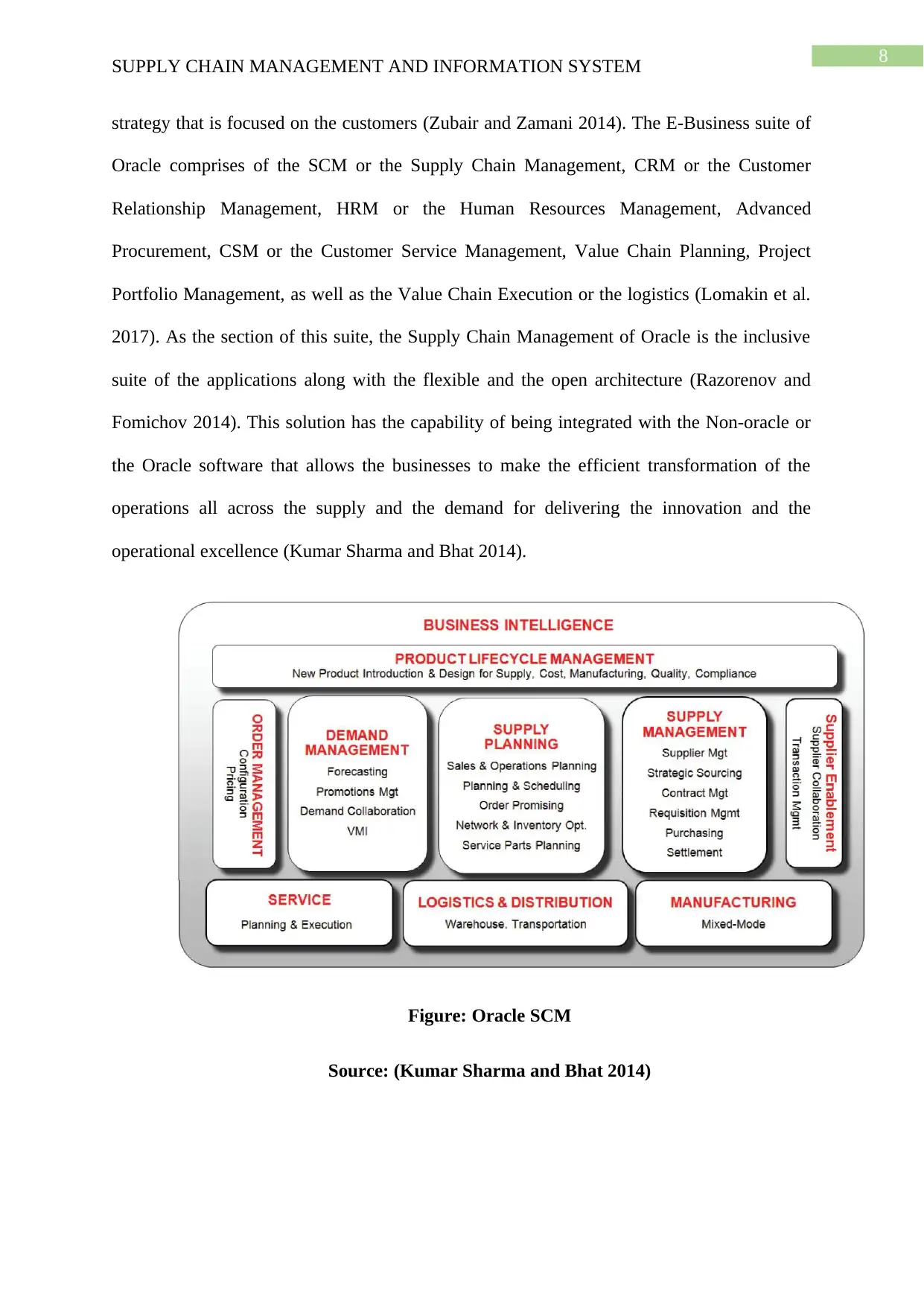
8
SUPPLY CHAIN MANAGEMENT AND INFORMATION SYSTEM
strategy that is focused on the customers (Zubair and Zamani 2014). The E-Business suite of
Oracle comprises of the SCM or the Supply Chain Management, CRM or the Customer
Relationship Management, HRM or the Human Resources Management, Advanced
Procurement, CSM or the Customer Service Management, Value Chain Planning, Project
Portfolio Management, as well as the Value Chain Execution or the logistics (Lomakin et al.
2017). As the section of this suite, the Supply Chain Management of Oracle is the inclusive
suite of the applications along with the flexible and the open architecture (Razorenov and
Fomichov 2014). This solution has the capability of being integrated with the Non-oracle or
the Oracle software that allows the businesses to make the efficient transformation of the
operations all across the supply and the demand for delivering the innovation and the
operational excellence (Kumar Sharma and Bhat 2014).
Figure: Oracle SCM
Source: (Kumar Sharma and Bhat 2014)
SUPPLY CHAIN MANAGEMENT AND INFORMATION SYSTEM
strategy that is focused on the customers (Zubair and Zamani 2014). The E-Business suite of
Oracle comprises of the SCM or the Supply Chain Management, CRM or the Customer
Relationship Management, HRM or the Human Resources Management, Advanced
Procurement, CSM or the Customer Service Management, Value Chain Planning, Project
Portfolio Management, as well as the Value Chain Execution or the logistics (Lomakin et al.
2017). As the section of this suite, the Supply Chain Management of Oracle is the inclusive
suite of the applications along with the flexible and the open architecture (Razorenov and
Fomichov 2014). This solution has the capability of being integrated with the Non-oracle or
the Oracle software that allows the businesses to make the efficient transformation of the
operations all across the supply and the demand for delivering the innovation and the
operational excellence (Kumar Sharma and Bhat 2014).
Figure: Oracle SCM
Source: (Kumar Sharma and Bhat 2014)
⊘ This is a preview!⊘
Do you want full access?
Subscribe today to unlock all pages.

Trusted by 1+ million students worldwide
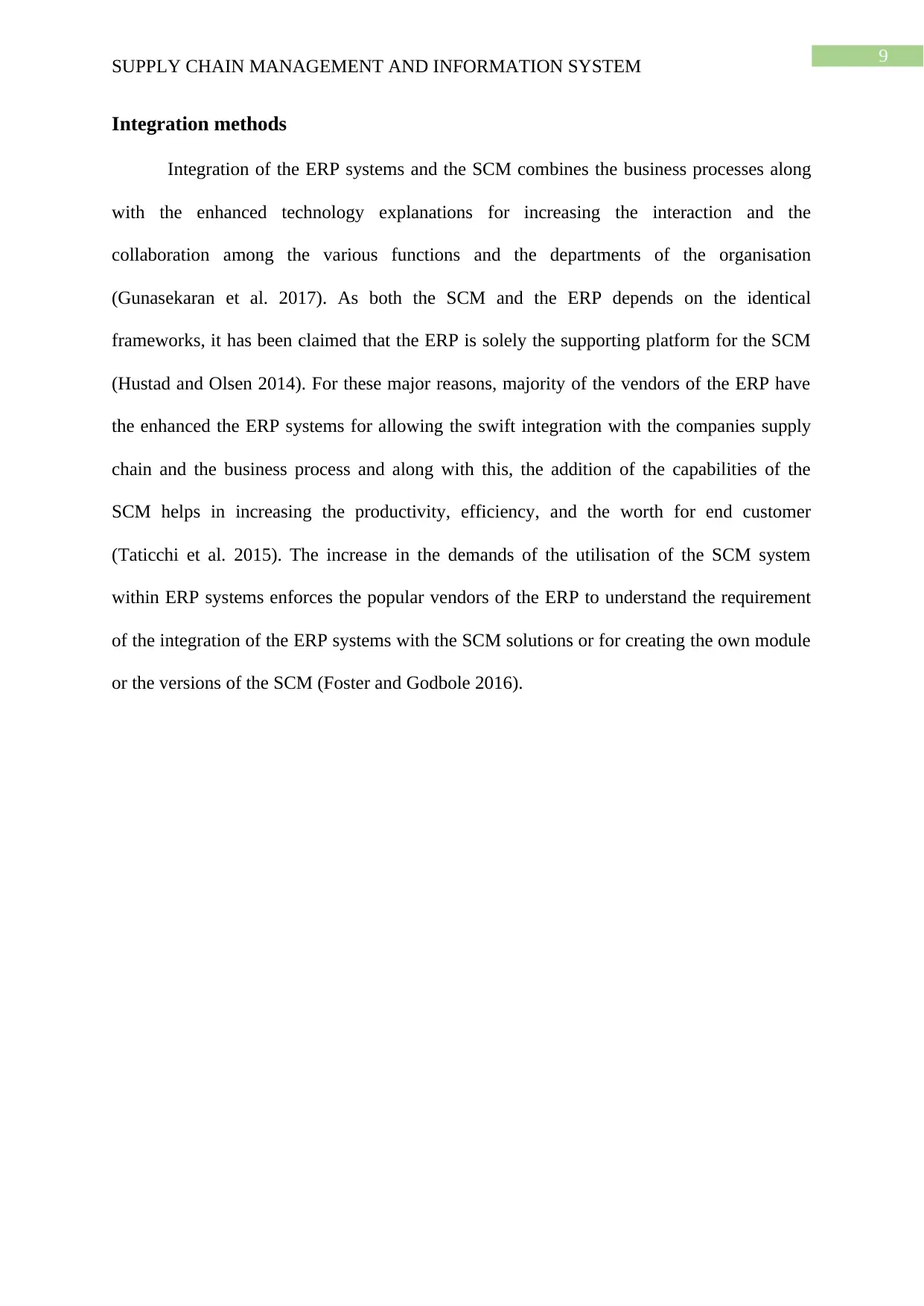
9
SUPPLY CHAIN MANAGEMENT AND INFORMATION SYSTEM
Integration methods
Integration of the ERP systems and the SCM combines the business processes along
with the enhanced technology explanations for increasing the interaction and the
collaboration among the various functions and the departments of the organisation
(Gunasekaran et al. 2017). As both the SCM and the ERP depends on the identical
frameworks, it has been claimed that the ERP is solely the supporting platform for the SCM
(Hustad and Olsen 2014). For these major reasons, majority of the vendors of the ERP have
the enhanced the ERP systems for allowing the swift integration with the companies supply
chain and the business process and along with this, the addition of the capabilities of the
SCM helps in increasing the productivity, efficiency, and the worth for end customer
(Taticchi et al. 2015). The increase in the demands of the utilisation of the SCM system
within ERP systems enforces the popular vendors of the ERP to understand the requirement
of the integration of the ERP systems with the SCM solutions or for creating the own module
or the versions of the SCM (Foster and Godbole 2016).
SUPPLY CHAIN MANAGEMENT AND INFORMATION SYSTEM
Integration methods
Integration of the ERP systems and the SCM combines the business processes along
with the enhanced technology explanations for increasing the interaction and the
collaboration among the various functions and the departments of the organisation
(Gunasekaran et al. 2017). As both the SCM and the ERP depends on the identical
frameworks, it has been claimed that the ERP is solely the supporting platform for the SCM
(Hustad and Olsen 2014). For these major reasons, majority of the vendors of the ERP have
the enhanced the ERP systems for allowing the swift integration with the companies supply
chain and the business process and along with this, the addition of the capabilities of the
SCM helps in increasing the productivity, efficiency, and the worth for end customer
(Taticchi et al. 2015). The increase in the demands of the utilisation of the SCM system
within ERP systems enforces the popular vendors of the ERP to understand the requirement
of the integration of the ERP systems with the SCM solutions or for creating the own module
or the versions of the SCM (Foster and Godbole 2016).
Paraphrase This Document
Need a fresh take? Get an instant paraphrase of this document with our AI Paraphraser
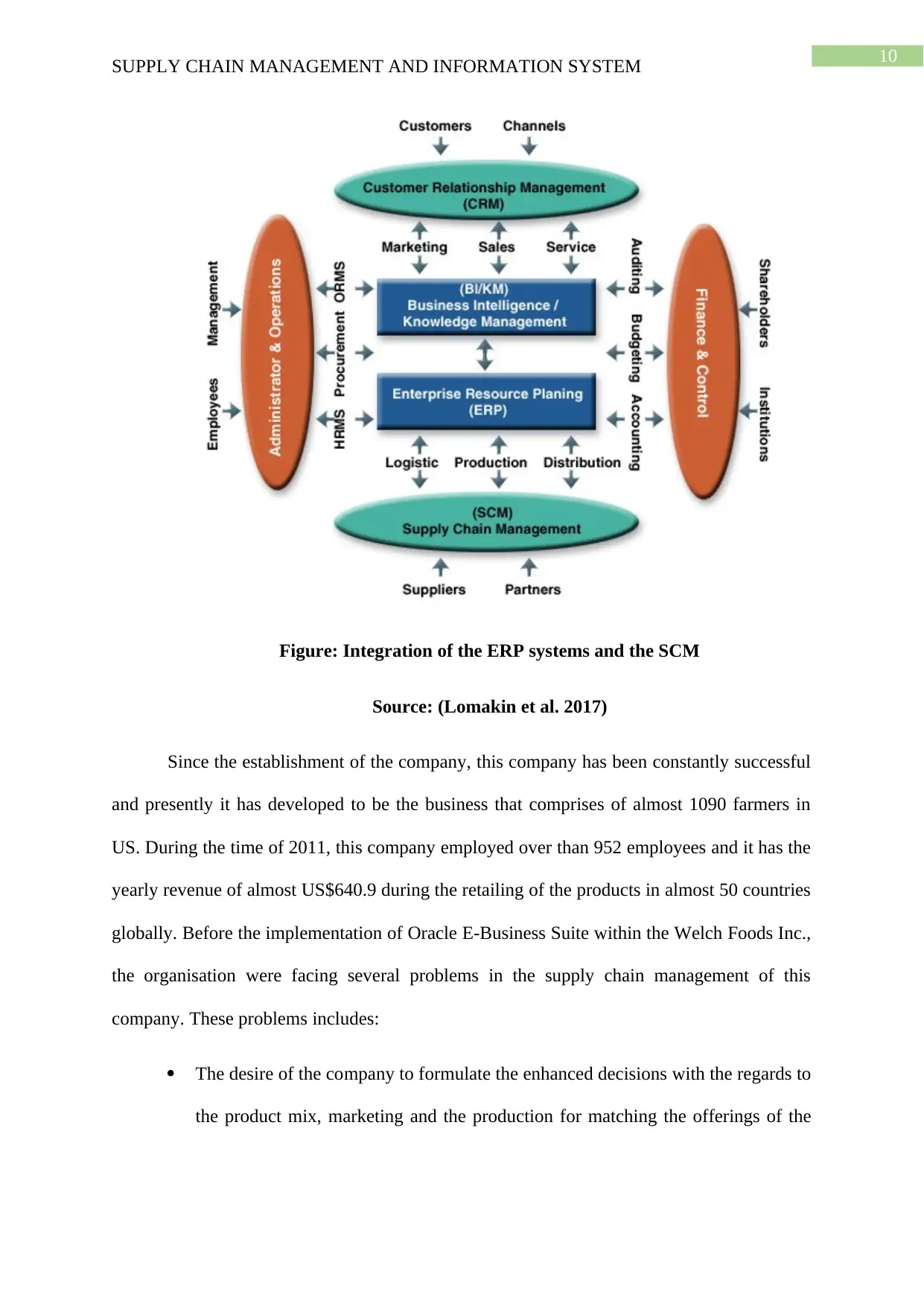
10
SUPPLY CHAIN MANAGEMENT AND INFORMATION SYSTEM
Figure: Integration of the ERP systems and the SCM
Source: (Lomakin et al. 2017)
Since the establishment of the company, this company has been constantly successful
and presently it has developed to be the business that comprises of almost 1090 farmers in
US. During the time of 2011, this company employed over than 952 employees and it has the
yearly revenue of almost US$640.9 during the retailing of the products in almost 50 countries
globally. Before the implementation of Oracle E-Business Suite within the Welch Foods Inc.,
the organisation were facing several problems in the supply chain management of this
company. These problems includes:
The desire of the company to formulate the enhanced decisions with the regards to
the product mix, marketing and the production for matching the offerings of the
SUPPLY CHAIN MANAGEMENT AND INFORMATION SYSTEM
Figure: Integration of the ERP systems and the SCM
Source: (Lomakin et al. 2017)
Since the establishment of the company, this company has been constantly successful
and presently it has developed to be the business that comprises of almost 1090 farmers in
US. During the time of 2011, this company employed over than 952 employees and it has the
yearly revenue of almost US$640.9 during the retailing of the products in almost 50 countries
globally. Before the implementation of Oracle E-Business Suite within the Welch Foods Inc.,
the organisation were facing several problems in the supply chain management of this
company. These problems includes:
The desire of the company to formulate the enhanced decisions with the regards to
the product mix, marketing and the production for matching the offerings of the
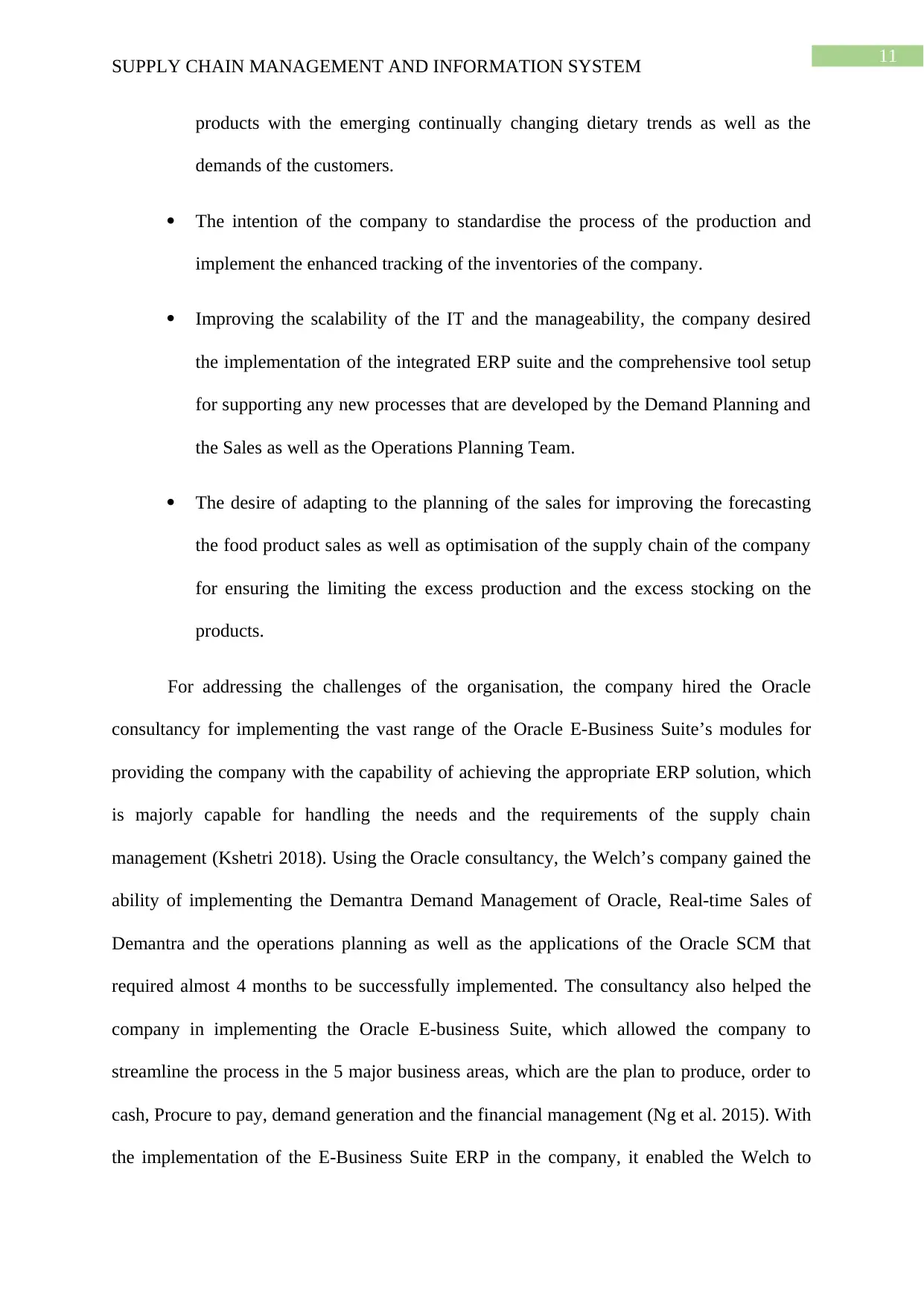
11
SUPPLY CHAIN MANAGEMENT AND INFORMATION SYSTEM
products with the emerging continually changing dietary trends as well as the
demands of the customers.
The intention of the company to standardise the process of the production and
implement the enhanced tracking of the inventories of the company.
Improving the scalability of the IT and the manageability, the company desired
the implementation of the integrated ERP suite and the comprehensive tool setup
for supporting any new processes that are developed by the Demand Planning and
the Sales as well as the Operations Planning Team.
The desire of adapting to the planning of the sales for improving the forecasting
the food product sales as well as optimisation of the supply chain of the company
for ensuring the limiting the excess production and the excess stocking on the
products.
For addressing the challenges of the organisation, the company hired the Oracle
consultancy for implementing the vast range of the Oracle E-Business Suite’s modules for
providing the company with the capability of achieving the appropriate ERP solution, which
is majorly capable for handling the needs and the requirements of the supply chain
management (Kshetri 2018). Using the Oracle consultancy, the Welch’s company gained the
ability of implementing the Demantra Demand Management of Oracle, Real-time Sales of
Demantra and the operations planning as well as the applications of the Oracle SCM that
required almost 4 months to be successfully implemented. The consultancy also helped the
company in implementing the Oracle E-business Suite, which allowed the company to
streamline the process in the 5 major business areas, which are the plan to produce, order to
cash, Procure to pay, demand generation and the financial management (Ng et al. 2015). With
the implementation of the E-Business Suite ERP in the company, it enabled the Welch to
SUPPLY CHAIN MANAGEMENT AND INFORMATION SYSTEM
products with the emerging continually changing dietary trends as well as the
demands of the customers.
The intention of the company to standardise the process of the production and
implement the enhanced tracking of the inventories of the company.
Improving the scalability of the IT and the manageability, the company desired
the implementation of the integrated ERP suite and the comprehensive tool setup
for supporting any new processes that are developed by the Demand Planning and
the Sales as well as the Operations Planning Team.
The desire of adapting to the planning of the sales for improving the forecasting
the food product sales as well as optimisation of the supply chain of the company
for ensuring the limiting the excess production and the excess stocking on the
products.
For addressing the challenges of the organisation, the company hired the Oracle
consultancy for implementing the vast range of the Oracle E-Business Suite’s modules for
providing the company with the capability of achieving the appropriate ERP solution, which
is majorly capable for handling the needs and the requirements of the supply chain
management (Kshetri 2018). Using the Oracle consultancy, the Welch’s company gained the
ability of implementing the Demantra Demand Management of Oracle, Real-time Sales of
Demantra and the operations planning as well as the applications of the Oracle SCM that
required almost 4 months to be successfully implemented. The consultancy also helped the
company in implementing the Oracle E-business Suite, which allowed the company to
streamline the process in the 5 major business areas, which are the plan to produce, order to
cash, Procure to pay, demand generation and the financial management (Ng et al. 2015). With
the implementation of the E-Business Suite ERP in the company, it enabled the Welch to
⊘ This is a preview!⊘
Do you want full access?
Subscribe today to unlock all pages.

Trusted by 1+ million students worldwide
1 out of 21
Related Documents
Your All-in-One AI-Powered Toolkit for Academic Success.
+13062052269
info@desklib.com
Available 24*7 on WhatsApp / Email
![[object Object]](/_next/static/media/star-bottom.7253800d.svg)
Unlock your academic potential
Copyright © 2020–2025 A2Z Services. All Rights Reserved. Developed and managed by ZUCOL.





